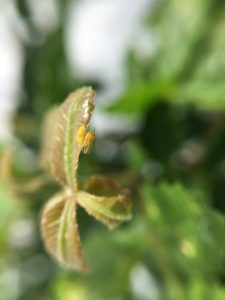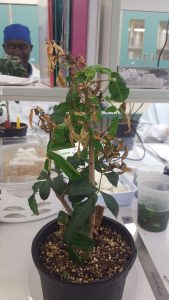Local, state, and federal agencies came together to release dozens of vials containing thrips (Pseudophilothrips ichini) insects in Saint Lucie, Collier, and Broward counties, Florida on July 16, 2019. These thrips are native to South America and are being used as a biological control to manage the growth and spread of Brazilian Peppertree, a highly invasive plant in Florida. A second release of the thrips is planned at Ft. Pierce 24 October 2019.
What should beekeepers know?
Based on cage trials at the USDA -ARS -Invasive Plant Research Laboratory according to Dr. Greg Wheeler, Research Entomologist, there could be as much as an 80% reduction in the leaf and tip production over the next 15 years. Picture cutting off the 2-3 inch green tip of 80% of branches. This is much less severe than trimming a hedge or pruning a tree. The trees need to expend more resources to replace damaged tissue, that would have been used in increased growth pre-thrips. There may be reduced seedling survival because without a tip bud, they cannot grow or will be stunted. That being said, this is an optimistic estimate and it may be years before we notice an impact of these releases on Brazilian Peppertree. In Brazil, the trees often show tip damage, but the trees still flower and produce fruit. Their growth is slowed so they don’t overwhelm nearby plants. Thus, we anticipate no major change to honey production in the immediate future. The impact will develop gradually, hopefully giving the Florida State Beekeepers Association, Florida Department of Agriculture and Consumer Services, and the University of Florida’s Institute of Food and Agricultural Sciences (UF/IFAS) time work with beekeepers to develop alternative management practices.
Here are a few things you might not know about Brazilian Peppertree and why the thrips and another insect are being released as biological control agents:
- Brazilian Peppertree is considered one of the most aggressive invasive weed species in Florida. It has dominated entire ecosystems in south-central Florida and has invaded natural sites and environmentally sensitive areas where it outcompetes with native species.
- Once established, Brazilian Peppertree quickly takes over native vegetation, forming dense monocultures and reduces the diversity of plants and animals. It produces allopathic chemicals that interfere with the germination of seeds of other plant species.

[Photo credit: Randy Westbrooks] - Because of its severe environmental impacts, Brazilian Peppertree is currently listed as a prohibited plant in Florida.
- Floridians have invested billions of dollars to restore and protect the Everglades from Brazilian Peppertree and other invasive species. It costs the public millions of dollars each year to manage non-native, invasive species.
- Chemical controls have been recommended and implemented to manage Brazilian Peppertree from spreading; however, these can be expensive, labor intensive, and only provide temporary control of the plants. The use of biocontrol agents helps to make chemical control more effective and ultimately reduces control costs.
- Brazilian peppertree thrips, Pseudophilothrips ichini, was released in 2019.

[Photo credit: Nick Silverson, USDA-ARS] - Yellow Brazilian peppertree leaf-galler, Calophya latiforceps has been approved for release which is expected to occur in 2020.

[Photo credit: Carree Minteer, University of Florida] - Insects must undergo rigorous testing by researchers to ensure they will not harm native organisms before they can be released as biological control agents of an invasive plant. This process usually takes years to complete and requires federal and state approval. Once the biological control is released, it takes another several years for the organism to establish and affect the invasive plant. UF/IFAS, the USDA, and FDACS scientists have been working on this research project since 2009.
- It has not been determined how often and how many thrips will be released; however, one should expect to see a reduction of Brazilian Peppertree leaf cover and bud growth over the next 15 years.
- The thrips will not kill the trees. Thus, the impact of these releases will not be immediately evident and will take time to develop.
- Brazilian peppertree thrips, Pseudophilothrips ichini, were released on July 16, 2019 and will be released again on 24 October 2019. Adult Brazilian Peppertree thrips can complete development and reproduce only on Brazilian peppertree. Both adults and larvae use their sucking mouthparts to feed on Brazilian Peppertree new growth, which reduces growth rate, plant height, number of leaves and green stems as well as flower, and fruit production.

[Photo credit: Carree Minteer, University of Florida] - Yellow Brazilian peppertree leaf-galler, Calophya latiforceps is another host specific natural enemy of Brazilian peppertree native to South America that will be released in 2020. Adults are found on new leaves of Brazilian Peppertree and cause no damage. The nymphs (immatures), however, create open pit galls and feed on plant sap, which causes leaf abscission, decreases photosynthesis and inhibits growth of the plant. The entire lifecycle of this insect is completed in the canopy. This insect will thrive in flooded situations where the Brazilian pepper thrips cannot survive. (Dr. Carey Minteer, UF/IFAS/IRREC)

[Photo credit: Rodrigo Diaz, LSU AgCenter, Baton Rouge, LA] - There are other insects already helping to control Brazilian pepper in Florida. The Streaked Sphinx moth, Protambulux strigillis, is native throughout the tropical Americas, including south Florida. It feeds on members of the poison ivy and cashew Family. It has always been here and never substantially damaged the Brazilian peppertree, because there are at least two parasitic flies (Tachinidae) that keep it under control. Other native moths had been seen feeding on Brazilian Peppertree as well. The Brazilian peppertree seed Chalcid wasp, Megastigmus transcaalensis, found its way to Florida as infested pink peppercorns sold in gourmet food markets before 1989. The wasps parasitize the drupes (fruits) of only Brazilian peppertrees in Florida, causing 31% seed failure in winter fruits and 76% in the spring fruit set. These insects to help reduce the invasiveness of Brazilian peppertree.
- There are many alternative nectar/pollen sources that can compete and flower at the same time as Brazilian peppertree (blooming period is typically September-November in Florida). This includes but is not limited to: Wild coffee (Psychotria nervosa), Coral vine (Antigonon leptopus), Prairie sunflower (Helianthus agrestis), Summer farewell (Petalostemon caroliniense), Camphorweed (Heterotheca subaxillaris), Florida milkweed (Asclepias feayi), Spanish needles (Bidens alba), Patridge pea (Cassia fasciculata), and Mexican clover (Richardia scabra).
For more information, please visit the links below:
Brazilian peppertree thrips
http://entnemdept.ufl.edu/creatures/BENEFICIAL/Pseudophilothrips_ichini.html
Yellow Brazilian peppertree leaf-galler
http://entnemdept.ufl.edu/creatures/beneficial/Calophya_latiforceps.htm
Classical Biological Control of Brazilian Peppertree in Florida
https://edis.ifas.ufl.edu/pdffiles/IN/IN11400.pdf
How Scientists Obtain Approval to Release Organisms for Classical Biological Control of Invasive Weeds
https://edis.ifas.ufl.edu/pdffiles/IN/IN60700.pdf
Brazilian Peppertree Seed Chalcid, Megastigmus transvaalensis
https://edis.ifas.ufl.edu/pdffiles/IN/IN45300.pdf
Brazilian Peppertree Control
https://edis.ifas.ufl.edu/pdffiles/AA/AA21900.pdf
Protambulux strigillis, Streaked Sphinx moth
https://bugguide.net/node/view/24324
This blog was written in collaboration between the University of Florida’s Institute of Food and Agricultural Sciences (UF/IFAS) Extension Faculty, the Florida Department of Agriculture and Consumer Services, and members of the Florida State Beekeepers Association. For more information on biological control of invasive plants at the University of Florida, check out Dr. Carey Minteer’s or Dr. Jim Cuda’s laboratories.
 0
0





